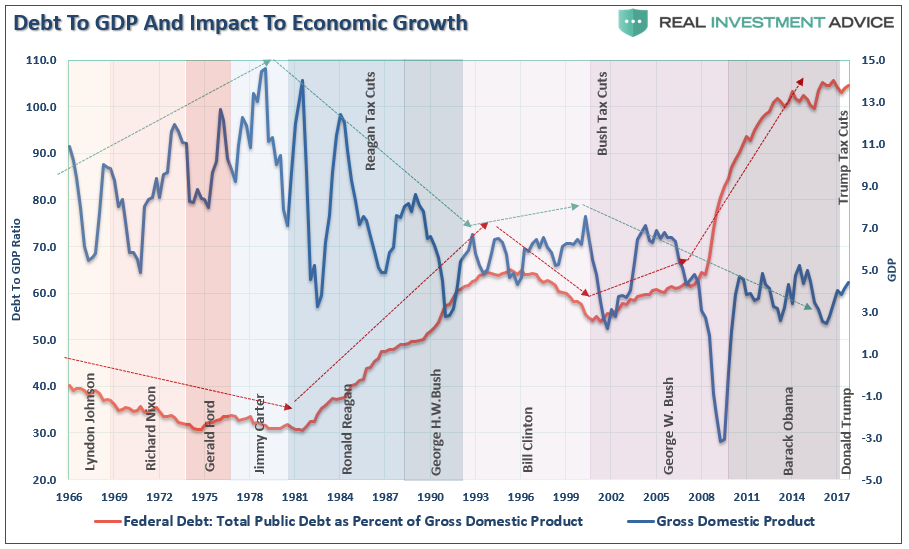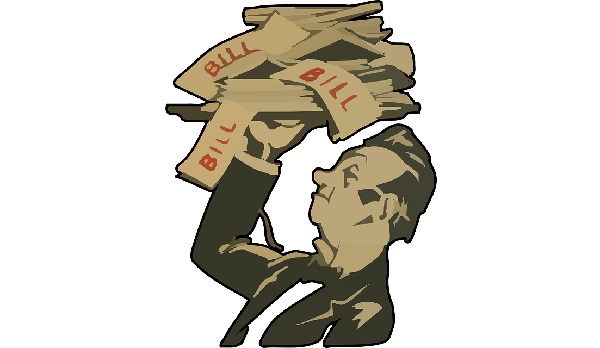Federal Debt: A Cancer on Economic Growth
The mainstream investment world is starting to worry about the federal debt.
Goldman Sachs sees a tidal wave of red ink — and it may drag the US economy into its undertow.”
Goldman recently released a note to clients saying virtually the same thing Peter Schiff has been saying for months. The US economy won’t likely get the promised economic growth out of GOP tax cuts – at least not over the long-haul.
Goldman estimated that the federal deficit would reach 5.2% of US growth by 2019 and would “continue climbing gradually from there.”
Again from CNBC:
‘The fiscal expansion should boost growth by around 0.7pp in 2018 and 0.6pp in 2019, but will likely come to an end after that’—listing a litany of reasons why spending and debt would conspire to undermine the world’s largest economy. While tax cuts are partly responsible, Goldman stated that ‘projected increases in mandatory spending—this includes Social Security, Medicare, Medicaid, and income support programs—are primarily responsible’ for an unsustainable surge in spending.”
The CBO conservatively estimates the debt-to-GDP ratio currently stands at 77%. But this is likely understated and leaves out a number of factors. Trading Economics calculated the 2017 debt-to-GDP ratio at 105.4%. A high debt-to-GDP ratio stymies economic growth. Even using the more conservative CBO number flashes giant warning signs. Last year, the CBO issued a dire forecast, saying the number could skyrocket to 150% by 2047 if the trend remains unchecked.
And Congress has shown no inclination to check the trend.
The budget plan passed last month added another $300 billion in spending over the next two years and raised the mythical debt ceiling.
Lance Roberts at RealInvestmentAdvice.com broke down the long-term impact of the budget deal. The continuing resolution added an 8% spending increase to the previous baseline. That means the higher level of spending now becomes the new baseline.
This means over the next decade, the C.R. will add $2 trillion in spending to the federal budget. Then add to that any other spending approved such as the proposed $200 billion for an infrastructure spending bill, money for DACA/immigration reform, or a whole host of other social welfare programs that will require additional funding. But that is only half the problem. The recent passage of tax reform will trim roughly $2 trillion from revenues over the next decade as well.”
Roberts’ conclusion? “There will be no economic boom.”
Deficits, and deficit spending, are highly destructive to economic growth as it directly impacts gross receipts and saved capital equally. Like cancer – running deficits, along with continued deficit spending, continues to destroy saved capital and damages capital formation. Debt is, by its very nature, a cancer on economic growth. As debt levels rise it consumes more capital by diverting it from productive investments into debt service. As debt levels spread through the system it consumes greater amounts of capital until it eventually kills the host. The chart below shows the rise of federal debt and its impact on economic growth.”

Goldman also hit another theme we’ve been harping on – the impact of rising interest rates on the debt.
We expect rising interest rates and a rising debt level to lead to a meaningful increase in interest expense. On our current projections, federal interest expense will rise to 2.3 percent of GDP by 2021,” and could hit 3.5 percent by 2027.”
In other words, it will cost the US government even more money just to make its annual interest payments on the debt. That means Washington will have to borrow even more money, creating a vicious cycle of skyrocketing debt and borrowing. This doesn’t even take the bigger question into consideration: Who is going to buy all of this debt?
Simon Black at Sovereign Man recently penned an interesting note on this:
Less than two weeks ago, the United States Department of Treasury very quietly released its own internal projections for the federal government’s budget deficits over the next several years. And the numbers are pretty gruesome. In order to plug the gaps from its soaring deficits, the Treasury Department expects to borrow nearly $1 trillion this fiscal year. Then nearly $1.1 trillion next fiscal year. And up to $1.3 trillion the year after that. This means that the national debt will exceed $25 trillion by September 30, 2020.”
This is a problem. The Federal Reserve is shedding assets from its balance sheet, and the Chinese and Japanese both seem to be out to the US Treasury market. That means interest rates may have to increase even more than anticipated in order to entice people to buy all of these bonds. Sovereign Man summed up the implications of soaring interest rates.
Make no mistake: higher interest rates will have an enormous impact on just about EVERYTHING. Many major asset prices tend to fall when interest rates rise. Rising rates mean that it costs more money for companies to borrow, reducing their leverage and overall profitability. So stock prices typically fall. It’s also important to note that, over the last several years when interest rates were basically ZERO, companies borrowed vast sums of money at almost no cost to buy back their own stock. They were essentially using record low interest rates to artificially inflate their share prices. Those days are rapidly coming to an end.”
Lance Roberts is probably on to something. It’s hard to see how we’re going to have this promised economic boom. Even the mainstream seems to be catching on.
Get Peter Schiff’s most important Gold headlines once per week – click here – for a free subscription to his exclusive weekly email updates.
Interested in learning how to buy gold and buy silver?
Call 1-888-GOLD-160 and speak with a Precious Metals Specialist today!





 Since Nayib Bukele became president of El Salvador, El Salvador has been in American media and global political discussion more than ever. While much of the attention focuses on Bukele’s mass incarceration of gang members and a decline in homicide of over 70%, Bukele has also drawn attention to his favoritism towards Bitcoin and how he […]
Since Nayib Bukele became president of El Salvador, El Salvador has been in American media and global political discussion more than ever. While much of the attention focuses on Bukele’s mass incarceration of gang members and a decline in homicide of over 70%, Bukele has also drawn attention to his favoritism towards Bitcoin and how he […] With gold hitting yet another awe-inspiring all-time high in the wake of Powell’s remarks reassuring markets (more or less) to expect rate cuts in 2024, a few analysts are pointing out risk factors for a correction — so is there really still room to run?
With gold hitting yet another awe-inspiring all-time high in the wake of Powell’s remarks reassuring markets (more or less) to expect rate cuts in 2024, a few analysts are pointing out risk factors for a correction — so is there really still room to run? Gold hit a new all-time nominal high, surpassing the previous record set in December of the previous year. The precious metal’s price reached approximately $2,140, indicating a robust and continuing interest in gold as a safe-haven asset, despite a rather peculiar lack of fanfare from the media and retail investors. This latest peak in gold […]
Gold hit a new all-time nominal high, surpassing the previous record set in December of the previous year. The precious metal’s price reached approximately $2,140, indicating a robust and continuing interest in gold as a safe-haven asset, despite a rather peculiar lack of fanfare from the media and retail investors. This latest peak in gold […] The gold price has been surging, with unprecedented central bank demand gobbling up supply. It has been a force to behold — especially as US monetary policy has been relatively tight since 2022, and 10-year Treasury yields have rocketed up, which generally puts firm downward pressure on gold against USD.
The gold price has been surging, with unprecedented central bank demand gobbling up supply. It has been a force to behold — especially as US monetary policy has been relatively tight since 2022, and 10-year Treasury yields have rocketed up, which generally puts firm downward pressure on gold against USD.  Total gold demand hit an all-time high in 2023, according to a recent report released by the World Gold Council. Last week, the World Gold Council (WGC) released its Gold Demand Trends report, which tracks developments in the demand for and use of gold around the world. Excluding over-the-counter (OTC) trade, 2023 gold demand fell slightly from 2022 […]
Total gold demand hit an all-time high in 2023, according to a recent report released by the World Gold Council. Last week, the World Gold Council (WGC) released its Gold Demand Trends report, which tracks developments in the demand for and use of gold around the world. Excluding over-the-counter (OTC) trade, 2023 gold demand fell slightly from 2022 […]